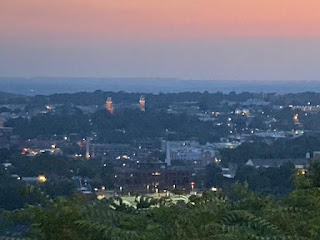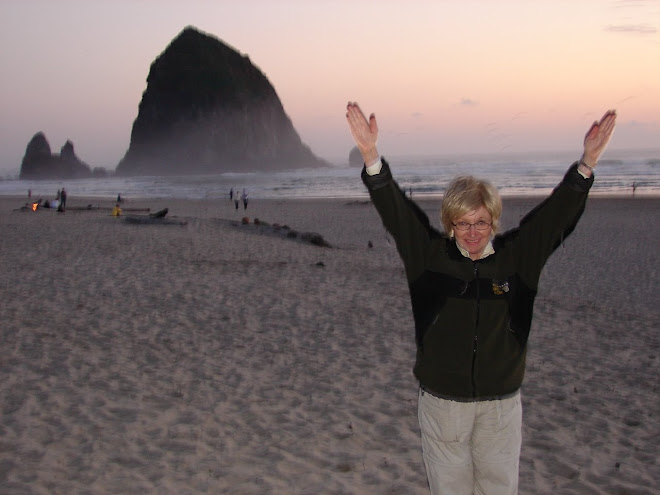 The mural shown in this photo uses the space inside the big block letters that spell out Mount Sequoyah to show you glimpses of all there is to discover at this incredible location. Likewise, I will try to use this blog post to share with you, the enjoyable visit I spent on that famous mountain recently.
The mural shown in this photo uses the space inside the big block letters that spell out Mount Sequoyah to show you glimpses of all there is to discover at this incredible location. Likewise, I will try to use this blog post to share with you, the enjoyable visit I spent on that famous mountain recently.This photo shows the original native stone columns at the main entrance of the property, that hold the big swinging gates, purposely left open, to show that all are welcome. If you are familiar with Fayetteville, Arkansas, the way it was decades ago, you may remember that this property used to be called the Mount Sequoyah Assembly. It was founded by the Methodist Episcopal Church as a summer retreat, spiritual center and training facility.
I was there to attend a three-day, two-night conference on urban forestry. I was doing this activity to get the continuing education hours I needed to maintain my annual certification as an Arkansas Master Naturalist (www.arkansasmasternaturalists.org). My room was on the second floor of Yancey Lodge, built around mid-century of 1900.
I was glad to see, that like almost all the hotels I stay in, there was a Gideon Bible in the drawer of the bedside table in my room.
I had a nice view of this sculpture from my room. If you look in the center of the sculpture, you will see the famous Mount Sequoyah cross
From my room in Yancey Lodge (which faces the street where the cross is situated), I could follow the stone sidewalk, walk between the native stone columns, and be at the location of one of the best outdoor viewpoints in all of Fayetteville, Arkansas!
From my room in Yancey Lodge (which faces the street where the cross is situated), I could follow the stone sidewalk, walk between the native stone columns, and be at the location of one of the best outdoor viewpoints in all of Fayetteville, Arkansas!
My room also looked out over the area known as Vesper Point. When I attended church camp, Vespers was what we called the evening prayer gathering. The word originates from Old French vespre, from Latin vesper ("evening star").
When I was in college decades ago in Fayetteville, we could pull our cars up to the very edge of the wall, that was just high enough to keep your tires from accidentally rolling off the mountain. Now, large, metal, farm watering troughs, have been repurposed to serve as planters for flowers, and to block off the former parking lot, so that it is free for pedestrians to stroll through. Those who drive cars to the view point can park their cars within the Mount Sequoyah grounds, near the Vespers Point area.
There are tennis courts on the perimeter of the property, and the MUCH larger than life tennis racket and tennis ball, assure that no one mistakes this area for anything but tennis!
Although I was tempted, I did not attempt to ring the large bell at the Waddell Bell Tower. Back in the days before everyone had a cell phone in their pocket, a bell that could be heard from miles away, was a handy tool to alert folks that something important was happening!
On my walk around the perimeter of the Mount Sequoyah property, I came across the unmistakable architecture of the well known Fayetteville architect, E. Fay Jones. I had to smile when I saw that the home also had a signature-designed E. Fay Jones mailbox, because back in the last century my husband and I were in our pickup truck, leaving a gathering at an E. Fay Jones-designed home in Harrison, Arkansas. Unfortunately, in the darkness (this was before the days of backup cameras on the dash board), my husband backed over our hosts' famous mailbox, and high-centered the truck on top of it, so that the tires were spinning in the air and going nowhere! The guests who were still inside the house came outside to see what the commotion was all about. One of the guests was an attorney. She handed my husband her business card, and said, "You have just destroyed the most expensive mail box in Boone County. You are probably going to need a lawyer." Fortunately, insurance helped cover the replacement costs! Later, I heard that the daughter of the host, who was a classmate of my son, was chatting with my son and others, and commented that "some redneck doctor from Mountain Home demolished our architect-designed mailbox Saturday night." My son never let on like he knew what she was talking about, or that he was well acquainted with that "red neck doctor" she referenced!
Toward the east of the E. Fay Jones house, there is a hiking/mountain biking trail that leads from the top of the mountain, down to a public street, near Crossover Road in Fayetteville. I can assure you it is easier hiking down this mountain, than starting from the lower end, and hiking upward (which is what I had done a year earlier---at least till I gave out and turned back!)
The Arkansas pioneers built their fences out of what was readily available, and that was native stone, or trees. The perimeter of the Mount Sequoyah property, is defined by this old-fashioned split rail fence.
This newly-reconfigured seating area around the Mount Sequoyah cross has become a popular gathering spot in Fayetteville, for "Sunset Ceremonies", like the ones in Key West, Florida. It is even listed as one of the "Top Ten" free things to do in Fayetteville!
Lots of people were there, taking lots of photos; so it was easy to offer to take photos of others, after which they obligingly took a photo of me by the cross.
When I was sitting on the rock wall that borders the street where the cross is located, I came across something I had never seen on my previous visits to this place. The metal marker was dated 1935, and had an address in Washington, D.C., one could write for more information. There was a warning about a $250 fine for "disturbing" the marker, so I left it as I found it! The geological marker is shown below:
From the location of the cross, one can see the towers of Old Main adorned in light, on the campus of the University of Arkansas. It will tell you how ancient I am, by mentioning that I actually had classes in Old Main, which was my freshman Honors English class, taught by Mrs. Eisley. It was a wonderful class that I am eternally grateful to Mrs. Eisley for teaching. That is because she used the Book of Psalms as her reference for teaching poetry. Up until that point, the only psalm I could remember reading was the 23rd Psalm, so it was an eye-opening experience to go through that book with an English teacher, pointing out the similes, and metaphors and rhythmic chants found within the pages of the psalms. These days, classes are no longer held within Old Main, but it remains a treasured symbol of the University of Arkansas.
As I mentioned in the beginning, my reason for being at the Mt. Sequoyah center, was to attend a continuing education conference on Urban Forestry. So our group went to visit some "Urban Trees", that are SO remarkable, they get a special plaque proclaiming their prominence, and are called Champion Trees. You can learn more about them by going to the website for the Arkansas Department of Agriculture, at www.agriculture.arkansas.gov . The left photo shows me beside the marker for the Arkansas-record-holding sugar maple tree, which is located in the Confederate Cemetery in Fayetteville. Years earlier, I had taken my grandkids to see that same Champion Sugar Maple Tree, and their photo in front of the tree, is seen on the right.
Our next visit was the incredibly designed Fayetteville Public Library. Our purpose at this location was to see the sustainable landscaping placed around the library, funded in part, by a grant from the Forestry Division of the Arkansas Department of Agriculture. A staff member from that agency guided our tour of the exterior.
After the outdoor tour at the library, we headed indoors for a tour of the dendrology lab on the campus of the University of Arkansas. We were honored to get to meet the head of their dendrology lab, the world-renown, Dr. Davis Stahle, shown in photo below. He explained the scientific research that his graduate students are conducting using tree rings, as indicators of climate change and ecological conditions.
We were able to crowd together for a group photo in the hallway outside his office:

I liked having my photo made between these two massive tree cookies, because the number of rings on them show that they are even older than I am!
Another part of our conference was learning about the work an urban forester must consider when it is time for a tree to come down, because it is diseased, or otherwise compromised. It is one thing to cut down a single tree in the middle of a field, but quite another to take down a tree with in a stand of tree, surrounded by historic buildings! It is not a time to use "guesstimates"!
This professional gave us a presentation of all the equipment they use when taking down an urban tree, always keeping safety top of mind. (Notice the harness he is wearing, plus a protective eye shield and microphone extending from his helmet) The two-way radio system allows the operator on the ground to communicate with the operator within the elevated bucket. We learned the difference between a dendrologist, who does scientific studies of trees, whereas an arborist works with living trees.
The sign in the photo below shows who the sponsors of this workshop were: The Arkansas Department of Agriculture Forestry Division, the Urban and Community Forestry group, as well as the Arkansas Forestry Educational Foundation (www.arkforests.org)





















.jpg)
